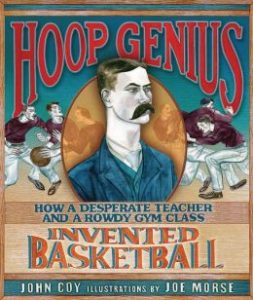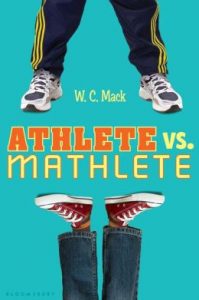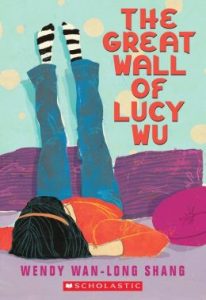This post should have gone up during March Madness, but even if the NCAA tournament is over this weekend, the NBA has few months to run. And we have new basketball books, from the history of the game to the joy of playing!
H.O.R.S.E.: A Game of Basketball and Imagination, by Christopher Meyer. Edgemont, 2012, 32 pages. Age/interest level: 4-6.
Two kids meet on an urban basketball court: Hey, you want to play a game of ‘Horse’? Horse or



In December of 1891, James Naismith, a young teacher, took over a gym class that had already forced two teachers to quit. Bored with jumping jacks and too physical for indoor football, the high-spirited young men at the YMCA might have put each other in the hospital if Naismith hadn’t stayed up late one night thinking up a new game. He based on it a rough-and-ready childhood pastime called Duck on a Rock, which depended more on skill than brute force. Next day, he grabbed a soccer ball and asked the building superintendent for two boxes. No boxes were available, but the super offered a couple of peach baskets . . . and the rest is history. This entertaining picture book creates a period atmosphere with its sepia-toned, turn-of-the-century mustaches, stiff collars and dungarees. The facial expressions are priceless—and be sure to catch an equally priceless artifact on the endpapers: the original typed rules of “Basket Ball,” with annotations in Naismith’s handwriting. My one caveat is that the subject matter is likely to interest older kids more than the usual picture-book crowd, and they would probably like a little more information. This book might inspire them to look it up, though.
Athlete vs. Mathlete, by W. C. Mach. Bloomsbury, 2013, 198 pages. Age/interest level: 9-13.
Owen and Russell are twins, but couldn’t be less alike; not only in appearance but also in ability, temperament and interests. 

The Cinderella aspect (likeable geek becomes brilliant b-ball player) stretches belief, as does the stereotyped snotty rich kid who tries to take over Russell’s academic team. Also, switching back and forth between the two brothers’ points of view can be a little confusing, but that just means a player—er, reader—has to keep on his toes. Otherwise the story moves along with believable tension building between the brothers, who love each other but have issues with turf invasion. I like their intact family life, especially their dad, who’s not only involved but ready with a word of wisdom when needed. Their faith is in family, and family is not enough—still it’s nice to see “family values” reinforced on the basketball court.
Note: Owen and Russell will appear again in Double Dribble, available this November.
- Worldview/moral value: 4 (out of 5)
- Literary value: 3.5
The Great Wall of Lucy Wu, by Wendy Wan-Long Shang. Scholastic, 2011, 312 pages. Age/interest level: 9-13.


Astute readers will guess that the wall is going to come down, but the cultural dimension adds both interest and empathy. Lucy is encouraged—i.e., forced—to go to Chinese school to improve her language skills and learn to appreciate her heritage. That, and her developing relationship with Li Po, begins the melting process:
Even after two years, there were times when my grandmother’s death felt like a fresh cut. I missed her so much. If I could, I would have told Yi Po I felt the same, but all I had were clunky nouns and adjectives, and everyday phrases. Red cup! Big desk! Let’s eat! I needed the small, delicate words that said: I know how you feel. I miss her too. She was special. She was irreplaceable.
Not exactly a sports novel, but basketball forms a major narrative thread, spinning off a subplot involving a mean girl and building up to the big student/faculty game. I won’t tell you who wins, because getting there is at least half the fun.
- Worldview/moral value: 4
- Literary value: 4
Play Makers, by Mike Lupica. Scholastic, 2013, 201 pages. Age/interest level: 10-14.
This is title #2 in a four-volume series that follows four middle-school friends (the Core Four) through athletic seasons. Game Changers ended with a football game for the record books, but now it’s basketball season, and protagonist Ben McBain is learning new meanings of the word competition. Not only does Chase Braggs, star player on the rival school’s team, threaten Ben’s moves on the court, but he quickly becomes a rival for the affections of Ben’s best friend Lily. (Not girlfriend, or not yet.) Rivalry coupled with jealousy is a dangerous combination.
This is Lupica’s twelfth sports novel for kids (see Million Dollar Throw) and shares some basic Lupica elements: band of brothers, female best friend, sportsmanship challenges. But above all, the game. As a sports reporter for the New York Daily News and ESPN, he knows the plays and strategies, agonies and thrills. Human drama seems more interesting for him as a backdrop for sports, rather than the sport as a metaphor for human life. He doesn’t have much of an ear for how middle-school students really talk (they all sound like teens in a 1980s after-school special) and the plotlines are a little too pat. The upside, for a sports fan, is plenty of on-the-court action. And parents can appreciate clean, straightforward storytelling where sportsmanship triumphs and character matters.
- Worldview/moral value: 4
- Literary value: 3
Stay Up to Date!
Get the information you need to make wise choices about books for your children and teens.
Our weekly newsletter includes our latest reviews, related links from around the web, a featured book list, book trivia, and more. We never sell your information. You may unsubscribe at any time.
Support our writers and help keep Redeemed Reader ad-free by joining the Redeemed Reader Fellowship.
Stay Up to Date!
Get the information you need to make wise choices about books for your children and teens.
Our weekly newsletter includes our latest reviews, related links from around the web, a featured book list, book trivia, and more. We never sell your information. You may unsubscribe at any time.
FREE Bible Guide!
Get a guide to the Best Bibles for Children and Teens. Perfect for an Easter gift.
We'd love to hear from you!
Our comments are now limited to our members (both Silver and Golden Key). Members, you just need to log in with your normal log-in credentials!
Not a member yet? You can join the Silver Key ($2.99/month) for a free 2-week trial. Cancel at any time. Find out more about membership here.
1 Comment
Leave a Comment
You must be logged in to post a comment.


I’m going to have to check out that twins book, Janie! My boys share the same DNA but are QUITE different…. Hope you enjoyed Lucy Wu!